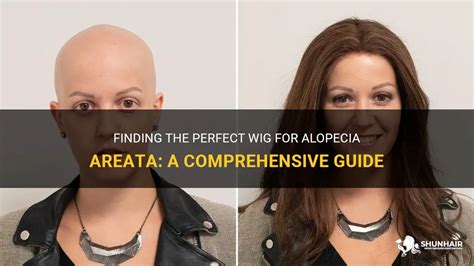Alopecia, a condition characterized by hair loss, can significantly impact an individual’s self-esteem and social well-being. While there is no cure for alopecia, there are effective strategies for managing its effects and restoring confidence. Wigs play a vital role in this process, offering a versatile and stylish solution for covering hair loss and enhancing appearance.

What is Alopecia?
Alopecia refers to hair loss that can occur due to various factors, including genetics, hormonal imbalances, medical conditions, and certain medications. According to the National Alopecia Areata Foundation (NAAF), approximately 6.8 million Americans suffer from alopecia areata alone, an autoimmune disorder that causes patchy hair loss.
How Can Wigs Help with Alopecia?
Wigs provide an immediate and effective solution for concealing hair loss, restoring self-confidence, and supporting overall well-being. They offer several benefits for individuals with alopecia:
- Cover hair loss: Wigs provide a discreet and customizable solution for covering bald patches or thinning hair.
- Enhance appearance: Wigs can enhance appearance by adding volume, length, and styling options to the hair.
- Boost confidence: By covering hair loss, wigs can boost confidence and reduce feelings of self-consciousness.
- Protect scalp: Wigs can protect the scalp from sun damage and irritation, especially for individuals with alopecia areata.
Types of Wigs for Alopecia
Various types of wigs are available for individuals with alopecia, each offering unique features and benefits:
- Full lace wigs: Made with a lace base that covers the entire head, providing a natural-looking hairline and scalp.
- Lace front wigs: Feature a lace front that mimics a natural hairline, while the rest of the wig is made of synthetic or human hair.
- Monofilament wigs: Constructed with a monofilament base, which creates the illusion of a natural scalp and allows for better air circulation.
- Synthetic wigs: Made from synthetic fibers, these wigs are affordable and easy to maintain.
- Human hair wigs: Made from human hair, these wigs offer a more natural look and feel but require more care and styling.
Choosing the Right Wig for Alopecia
Selecting the right wig for alopecia requires careful consideration of individual needs and preferences:
- Hair loss pattern: The type of wig should match the hair loss pattern, such as full lace for complete coverage or lace front for partial hair loss.
- Wig type: Synthetic wigs offer affordability and low maintenance, while human hair wigs provide a more natural look.
- Face shape: Different wig styles suit different face shapes. Consult with a hairstylist to determine the most flattering option.
- Color and texture: Choose a wig color and texture that complements the natural hair or desired style.
- Fit and comfort: Ensure the wig fits securely and comfortably on the head, avoiding friction and irritation.
Applying and Caring for Wigs for Alopecia
Appropriate application and care are essential for maintaining the appearance and longevity of wigs:
- Proper fitting: Have the wig professionally fitted to ensure a secure and comfortable fit.
- Wig cap: Wear a wig cap underneath the wig to protect the scalp and reduce slippage.
- Styling: Use heat styling tools cautiously on synthetic wigs and avoid excessive heat on human hair wigs.
- Cleaning: Follow the manufacturer’s instructions for washing and conditioning the wig.
- Storage: Store the wig on a wig stand or hanger when not in use to prevent tangles and maintain its shape.
Social and Emotional Support for Alopecia
In addition to wigs, individuals with alopecia may benefit from social and emotional support:
- Support groups: Joining support groups can provide a sense of community and reduce feelings of isolation.
- Counseling: Therapy can help manage the emotional challenges associated with hair loss.
- Self-care: Prioritizing self-care through activities such as exercise, meditation, and connecting with loved ones can help boost well-being.
Table 1: Types of Wigs for Alopecia
| Wig Type | Description | Benefits |
|---|---|---|
| Full lace wigs | Lace base covers the entire head | Natural-looking hairline and scalp |
| Lace front wigs | Lace front mimics a natural hairline | Affordable and easy to maintain |
| Monofilament wigs | Monofilament base creates the illusion of a natural scalp | Breathable and allows for heat styling |
| Synthetic wigs | Made from synthetic fibers | More natural look and feel |
Table 2: Benefits of Wigs for Alopecia
| Benefit | Explanation |
|---|---|
| Conceals hair loss | Covers bald patches and thinning hair |
| Enhances appearance | Adds volume, length, and styling options |
| Boosts confidence | Reduces feelings of self-consciousness |
| Protects scalp | Shielding it from sun damage and irritation |
Table 3: Factors to Consider When Choosing a Wig for Alopecia
| Factor | Explanation |
|---|---|
| Hair loss pattern | Type of wig should match the hair loss pattern |
| Wig type | Synthetic or human hair, depending on budget and preference |
| Face shape | Different wig styles suit different face shapes |
| Color and texture | Complements natural hair or desired style |
| Fit and comfort | Secure and comfortable fit on the head |
Table 4: Wigs for Alopecia: Tips and Tricks
| Tip | Explanation |
|---|---|
| Use wig tape or glue for a secure fit | Prevents slippage and keeps the wig in place |
| Use a wig brush to detangle and style | Avoid regular hairbrushes that can damage the wig |
| Wash the wig as per manufacturer’s instructions | Regular cleaning maintains the wig’s appearance and prevents tangles |
| Keep the wig away from heat sources | High temperatures can damage synthetic wigs |
| Take breaks from wearing the wig | Allows the scalp to breathe and reduces irritation |
